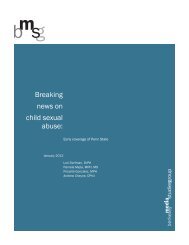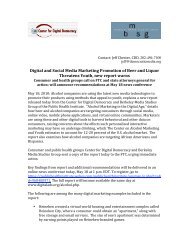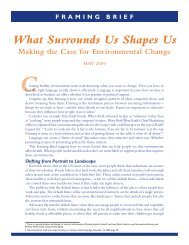Framing Brief_Soda_092309 - Berkeley Media Studies Group
Framing Brief_Soda_092309 - Berkeley Media Studies Group
Framing Brief_Soda_092309 - Berkeley Media Studies Group
You also want an ePaper? Increase the reach of your titles
YUMPU automatically turns print PDFs into web optimized ePapers that Google loves.
children learn how to make everyday decisions such as<br />
buying food and exercising. 53<br />
According to Jo Tuckman of The Guardian, a 2006 national<br />
survey reveals that 72% of Mexican adults are<br />
“overweight or obese” and a quarter of Mexican children<br />
between the ages of 5 and 11 are “too heavy”—an increase<br />
of 40% since 2000. The reporter says that Mexican<br />
officials refuse to comment “on how major players in the<br />
junk food industry became the highest profile motors<br />
behind the fight against childhood obesity.” 54<br />
At the end of May, 2008, the major soft drink companies<br />
announced that they would extend to the rest of<br />
the world their American pledges to stop targeting advertising<br />
to children under the age of 12.<br />
Instead of mimicking the U.S. policy worldwide, says<br />
Silverglade, the companies should have agreed to the<br />
stricter curbs demanded by the British government and<br />
to an international code of marketing of foods and beverages<br />
to children that has been proposed by world-wide<br />
consumer organizations.<br />
“Coke and Pepsi are proving that it’s hard to adopt a<br />
strong anti-obesity policy when your core products are<br />
major causes of obesity,” says Silverglade. 55<br />
<strong>Soda</strong> self-regulation<br />
The soda industry has always self-regulated its advertising,<br />
but by 2006, 43 states had enacted or introduced<br />
legislation to improve child nutrition in schools and the<br />
soda industry felt the pressure. 56 A national consortium<br />
of public health groups and lawyers<br />
was in negotiations with the companies<br />
when a one-time soda slugger,<br />
former President Bill Clinton,<br />
emerged as dealmaker.<br />
At first, according to Ira Magaziner,<br />
a Clinton aide working in his<br />
foundation, soda companies fought<br />
against restrictions in high school<br />
beverages. The industry asked why<br />
students who were nearly old<br />
enough to fight in Iraq should be refused<br />
their soda of choice, said Magaziner. 57 But in the<br />
end, the companies decided to acquiesce. Even then,<br />
Magaziner reported that industry resistance was so strong<br />
that they had to negotiate “drink by drink” before reaching<br />
agreement. 58<br />
The big three soda companies, along with the American<br />
Beverage Association (formerly the National Soft<br />
9<br />
“Coke and Pepsi are proving<br />
that it’s hard to adopt a strong<br />
anti-obesity policy when your<br />
core products are major causes<br />
of obesity.”<br />
Bruce Silvergrade, CSPI<br />
Drinks Association), agreed that by 2009-10, all full-calorie<br />
soda would be removed from elementary and middle<br />
schools and replaced by bottled water, unsweetened fruit<br />
juices and low-fat milk. High schools could sell diet<br />
drinks, unsweetened tea, lower-calorie sports drinks, and<br />
flavored water.<br />
The American Beverage Association announced a $10<br />
million ad campaign to “educate the country” about the<br />
new school beverage guidelines and the Alliance for a<br />
Healthier Generation was born, sponsored by Clinton’s<br />
Foundation and the American Heart Association, to<br />
make sure the goals were met.<br />
Tricia Garrison, marketing and communications director<br />
for the Alliance for a Healthier Generation, reports<br />
that schools have been on track during the first of the<br />
three-year phase.<br />
“Calories from beverages shipped to schools dropped<br />
41% across America,” she says. “There has been a 45%<br />
reduction in shipments of full-calorie soft drinks to the<br />
schools. And the average high school student consumed<br />
less than half a can of full-calorie soft drinks a week in<br />
school (5.9 ounces), compared with a little more than a<br />
full can a week (12.5 ounces) in 2004. Shipments of<br />
water are also up by 23% since 2004.” 59<br />
In November of 2006, nearly a year after the school<br />
drinks deal, the Council of Better Business Bureaus<br />
(CBBB) put together the Children’s Food and Beverage<br />
Advertising Initiative with the companies that accounted<br />
for two-thirds of children’s food and beverage TV advertising<br />
expenditures in 2004. Today,<br />
15 companies, including the big<br />
three soda companies, have signed on<br />
to the voluntary, self-regulation program.<br />
Each has made a pledge to devote<br />
at least 50% of its advertising<br />
directed to children under 12 years<br />
of age to promote healthier dietary<br />
choices and/or to messages encouraging<br />
good nutrition and/or healthy<br />
lifestyles. PepsiCo’s pledge differs<br />
from The Coca-Cola Company’s in<br />
that Pepsi will advertise Gatorade, baked Cheetos and<br />
crackers, as long as the ads show kids engaged in physical<br />
activity.<br />
“Coke and Pepsi are in compliance as far as I can tell<br />
now,” says Elaine Kolish, director of the Initiative and a<br />
former Federal Trade Commission regulator for 25 years,<br />
who is in charge of assuring industry compliance. 60









